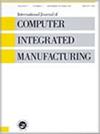基于人机交互的机器人拆卸信息提取
IF 4
3区 工程技术
Q2 COMPUTER SCIENCE, INTERDISCIPLINARY APPLICATIONS
International Journal of Computer Integrated Manufacturing
Pub Date : 2023-09-21
DOI:10.1080/0951192x.2023.2257667
引用次数: 0
摘要
摘要报废产品的拆解对循环原料循环、再利用循环、再制造循环的经济可行性至关重要。大批量拆卸操作受到拆卸复杂性和产品可变性的限制。对时间、数量和质量的不确定性的缓冲能力影响着拆解系统的效率和盈利能力。为了在制造生命周期中实现竞争性操作,拆卸系统需要自动化生产线,然而,核心供应的不可预测性对自动化适应性提出了挑战。手动编程或由视觉系统控制的拆卸机器人轨迹可能是时间密集型的,并且受到照明条件和图像识别模型的变化的影响。另外,本文提出了一种新的人机拆卸框架,用于系统地提取和生成由人机协作机器人(cobot)拆卸导出的机器人轨迹。提出的协同训练站对轨迹段进行分类,然后对大批量拆解线上特定工位的机器人调整轨迹。提出并讨论了虚拟和物理协同拆卸的案例研究。结果证明了拆卸数据提取方法的有效性,但由于人为操作的可变性,期望和理想的拆卸轨迹之间存在差异,本文将进一步讨论这一点。关键词:拆卸协作机器人再制造系统框架披露声明作者未报告潜在利益冲突。本研究由关键材料研究所与橡树岭国家实验室合作支持[FA-3.3.11]。本文章由计算机程序翻译,如有差异,请以英文原文为准。
Human-robot interaction for extraction of robotic disassembly information
ABSTRACTDisassembly of end-of-use products is critical to the economic feasibility of circular feedstock, reusing, recycling and remanufacturing loops. High-volume disassembly operations are constrained by disassembly complexity and product variability. The capability to buffer against timing, quantity and quality uncertainties of end-of-use products impacts the efficiency and profitability of demanufacturing systems. To achieve a competitive operation in the manufacturing life-cycle, disassembly systems need automated lines, however, the unpredictability of core supply challenges automation adaptability. Disassembly robot trajectories that are programmed manually or controlled by vision systems can be time intensive and subject to variability in lighting conditions and image recognition models. Alternatively, this paper presents a novel human-robot disassembly framework to systematically extract and generate robot trajectories derived from human-collaborative robot (cobot) disassembly. The collaborative training station proposed classifies trajectory segments and then adjusts trajectories to station-specific robots in a high-volume disassembly line. Virtual and physical collaborative disassembly case studies are presented and discussed. Results demonstrate the effectiveness of the disassembly data extraction method but indicate a disparity between the expected and ideal disassembly trajectories due to variability from human handling, which is further discussed in this paper.KEYWORDS: Disassemblycollaborative robotsremanufacturingsystem framework Disclosure statementNo potential conflict of interest was reported by the authors.Additional informationFundingThis work was supported by the Critical Materials Institute in collaboration with Oak Ridge National Laboratory [FA-3.3.11].
求助全文
通过发布文献求助,成功后即可免费获取论文全文。
去求助
来源期刊
CiteScore
9.00
自引率
9.80%
发文量
73
审稿时长
10 months
期刊介绍:
International Journal of Computer Integrated Manufacturing (IJCIM) reports new research in theory and applications of computer integrated manufacturing. The scope spans mechanical and manufacturing engineering, software and computer engineering as well as automation and control engineering with a particular focus on today’s data driven manufacturing. Terms such as industry 4.0, intelligent manufacturing, digital manufacturing and cyber-physical manufacturing systems are now used to identify the area of knowledge that IJCIM has supported and shaped in its history of more than 30 years.
IJCIM continues to grow and has become a key forum for academics and industrial researchers to exchange information and ideas. In response to this interest, IJCIM is now published monthly, enabling the editors to target topical special issues; topics as diverse as digital twins, transdisciplinary engineering, cloud manufacturing, deep learning for manufacturing, service-oriented architectures, dematerialized manufacturing systems, wireless manufacturing and digital enterprise technologies to name a few.

 求助内容:
求助内容: 应助结果提醒方式:
应助结果提醒方式:


